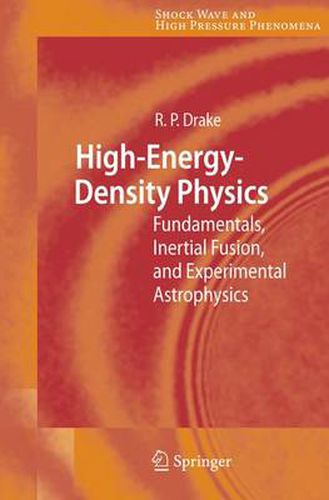Readings Newsletter
Become a Readings Member to make your shopping experience even easier.
Sign in or sign up for free!
You’re not far away from qualifying for FREE standard shipping within Australia
You’ve qualified for FREE standard shipping within Australia
The cart is loading…






This title is printed to order. This book may have been self-published. If so, we cannot guarantee the quality of the content. In the main most books will have gone through the editing process however some may not. We therefore suggest that you be aware of this before ordering this book. If in doubt check either the author or publisher’s details as we are unable to accept any returns unless they are faulty. Please contact us if you have any questions.
This book has two goals. One goal is to provide a means for those new to high-energy-density physics to gain a broad foundation from one text. The second goal is to provide a useful working reference for those in the ?eld. This book has at least four possible applications in an academic c- text. It can be used for training in high-energy-density physics, in support of the growing number of university and laboratory research groups working in this area. It also can be used by schools with an emphasis on ultrafast lasers, to provide some introduction to issues present in all laser-target - perimentswithhigh-powerlasers,andwiththoroughcoverageofthematerial in Chap. 11 on relativistic systems. In addition, it could be used by physics, applied physics, or engineering departments to provide in a single course an introduction to the basics of ?uid mechanics and radiative transfer, with d- matic applications. Finally, it could be used by astrophysics departments for a similar purpose, with the parallel bene?t of training the students in the similarities and di?erences between laboratory and astrophysical systems. The notation in this text is deliberately sparse and when possible a given symbol has only one meaning. A de?nition of the symbols used is given in Appendix A. In various cases, additional subscripts are added to distinguish among cases of the same quantity, as for example in the use of ? and ? 1 2 to distinguish the mass density in two di?erent regions.
$9.00 standard shipping within Australia
FREE standard shipping within Australia for orders over $100.00
Express & International shipping calculated at checkout
This title is printed to order. This book may have been self-published. If so, we cannot guarantee the quality of the content. In the main most books will have gone through the editing process however some may not. We therefore suggest that you be aware of this before ordering this book. If in doubt check either the author or publisher’s details as we are unable to accept any returns unless they are faulty. Please contact us if you have any questions.
This book has two goals. One goal is to provide a means for those new to high-energy-density physics to gain a broad foundation from one text. The second goal is to provide a useful working reference for those in the ?eld. This book has at least four possible applications in an academic c- text. It can be used for training in high-energy-density physics, in support of the growing number of university and laboratory research groups working in this area. It also can be used by schools with an emphasis on ultrafast lasers, to provide some introduction to issues present in all laser-target - perimentswithhigh-powerlasers,andwiththoroughcoverageofthematerial in Chap. 11 on relativistic systems. In addition, it could be used by physics, applied physics, or engineering departments to provide in a single course an introduction to the basics of ?uid mechanics and radiative transfer, with d- matic applications. Finally, it could be used by astrophysics departments for a similar purpose, with the parallel bene?t of training the students in the similarities and di?erences between laboratory and astrophysical systems. The notation in this text is deliberately sparse and when possible a given symbol has only one meaning. A de?nition of the symbols used is given in Appendix A. In various cases, additional subscripts are added to distinguish among cases of the same quantity, as for example in the use of ? and ? 1 2 to distinguish the mass density in two di?erent regions.